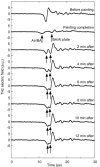Source:optics.org
Researchers in Japan unveil a terahertz system that measures the thickness of a layer of paint and its drying time.
When you think of where terahertz (THz) radiation is being used, applications such as security and medical imaging come to mind. Now, thanks to research being carried out at Osaka University in Japan, "watching paint dry" can be added to this list.
The Japanese team has developed an instrument called a paintmeter which uses THz pulses to measure the thickness and wet-to-dry transition of paint layers. A non-contact and remote system, the researchers believe their paintmeter is ideal for quality control tasks such as monitoring paint on car bodies. (Applied Optics 44 6849)

Paintme setup
"The painting of industrial products such as car bodies is important for rust prevention, waterproofing and color effect," researcher Takeshi Yasui told Optics.org. "Conventional thickness meters use methods such as ultrasonics, eddy-current testing and electromagnetic testing but these are all based on contact measurements."
As a typical layer of paint scatters visible and infrared light, the team decided to turn to terahertz frequencies when developing its paintmeter.

Echo from interfaces
"Using THz results in applicability to opaque or heavy-scattering paint films - even metallic paint films that contain a lot of fine metal flakes," explained Yasui. "Since there is a characteristic difference in THz absorption spectra between a wet and a dry paint film, the THz radiation is even suitable for monitoring the drying process."
Based on the principles of tomography, the paintmeter relies on the difference in refractive index between air and various paint layers to generate echoes.
Yasui and colleagues focus the output of a modelocked Ti:Sapphire laser oscillator on to a photoconductive antenna to generate broadband THz pulses. They then use free-space electro-optic sampling to pick up the echoes of the incident radiation from the various paint layers. An x-y stage scans the sample to measure the paint's thickness distribution.

Drying time
The team says that the paintmeter performed well in a number of tests. Scenarios included measuring the thickness of single layers of paints typically used on car bodies as well as point and distribution measurements of the thicknesses of layers in a multi-layer paint film. The drying time of a paint film was also measured.
Yasui says that the precision and resolution of the single-layer thickness measurements were 4 microns and a few tens of microns respectively.
"The point measurement in the present paper requires about 1 second and hence several minutes to obtain the 2D cross section of the paint film resulting in use limited to stationary objects," said Yasui. "For practical use in industrial applications, such as monitoring a moving object, real-time acquisition of 2D cross-sections will be required. Work is now in progress to achieve real time 2D THz tomography."
Author
Jacqueline Hewett is technology editor on Optics.org and Opto & Laser Europe magazine.

